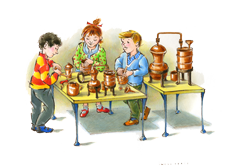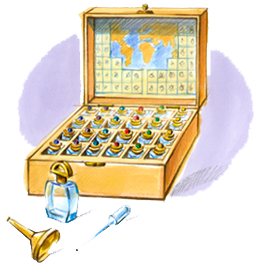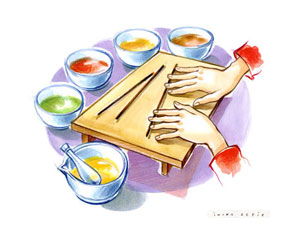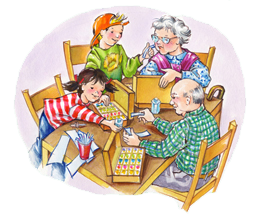From flower to perfume
Introduction to the art of perfume making. Presentation of the distillation process of an aromatic plant using a still, followed by an exploration of the raw materials used in the town of Grasse, in the south of France. The session finishes with the creation of your very own personalised perfume with the help of a perfume organ.
A vanilla-based perfume
After watching a film on the harvest and treatment of vanilla beans in La Réunion, an exploration of the absolute form of vanilla used in the composition of perfume. Moving on to a study of famous vanilla-based perfumes. The session concludes with the creation of a personalised scent, based on vanilla.
A spiced perfume
Discovery of the spices used in the creation of perfume: essential oils of clove, nutmeg, cardamom, coriander…Then a study of several famous perfumes based on these spices. The session ends with the creation of a perfume combining spicy notes with floral, fruity and woody notes.
A vetivert-based perfume
Journey to the heart of the Indian ocean to trace these famous roots. A film on their harvest and distillation. Then a study of several famous perfumes for which vetivert makes up an important element. The session concludes with the creation of a perfume based on the original notes of vetivert essence.
A frankincense-based perfume
Journey to the country of Oman, in a film depicting the famous frankincense tree, the ‘boswelia sacra’, from which is extracted the famous resin, which is then burnt. Discovery of this mythical component in the fabrication of perfumes which are burnt, as well as other resins and powders used to make incense sticks. Then practical work, making incense sticks.
Perfumer’s Iris
It is the pallida variety, originating in Tuscany, which provides the most precious raw material in the perfumer maker’s palette. After a film showing the harvesting of the pallida iris, a discovery of iris butter and an olfactory study of certain famous perfumes typically composed of iris. The session ends with the creation of a perfume which combines iris with woody, floral and grassy scents.
A jasmine- based perfume
Film of the harvest and extraction of jasmine in Grasse. Discovery of Grasse’s utmost treasure, reserved only for certain prestigious perfume houses. Then an olfactory study of some famous perfumes of which Jasmine constitutes the main component. The session concludes with the creation of a perfume, which marries the scent of jasmine with sandalwood, vetivert, rose…
History of Amber
After the showing of a film on the sperm whale and the amber trade, a discovery of amber used in perfume. Then an olfactory study of famous amber perfumes. The session ends with the creation of an amber perfume based on the scents of bergamot, rose, vetivert, patchouli
A lavender- based perfume
Journey to the heart of Provence, discovering the cultivation of lavender and lavandin. Film on its harvest and distillation. Olfactory examination of its essences then a study of famous perfumes which count lavender as an essential element. The session finishes with the creation of a perfume blending lavender with other essences.
Woody perfume
Discovery of several trees from which essences, resins and balms are extracted, useful in the creation of perfumes: rosewood, cedar, juniper, gaiac, styrax. Film on the exploitation of sandalwood in India, then a study of famous woody scents. The session ends with the creation of a perfume which blends woody, floral and balsamic notes among others.
A ylang ylang- based perfume
Journey to the heart of the Indian ocean in search of the ylang-ylang flower. Film on the harvest and the transformation of the flower into essence. Then a study of a perfume for which ylang-ylang is an important component. The session finishes with the creation of a perfume marrying the essence of ylang ylang with other essences.
Citrus Perfume
Discovery of citrus fruits used in the creation of perfumes: orange, mandarin, bergamot, lemon and lime essential oils. Film on the bergamot harvest in Calabria. Then a study of the creation of a traditional Eau de Cologne, such as Jean Marie Farina. The session concludes with the creation of an Eau de Cologne style perfume.
From lichen to ‘chypre’ perfume
Commonly referred to as oakmoss, tree moss or cedar moss by perfumers, this vegetation belongs to the vast family of lichens and produces, after extraction, a much revered perfume in the eyes of the perfume maker. Film on the pine lichen crop in Auvergne, central France, then an olfactory study of some famous perfumes based on oakmoss, from the chypre family. The session ends with the creation of a perfume blending oakmoss with woody, powdery and fruity notes among others.
A rose perfume
After the showing of a film on rose cultivation and extraction in Morocco and Turkey, discovery of the essence and absolute used in perfume. Then a study of the most prominent perfumes dominated by rose. The session finishes with the creation of a perfume, marrying rose extracts with woody, fruity and jasmine notes.
Perfumes of rainforest origin
In the quest for new sources of inspiration, perfume makers are exploring the tree-tops of the equatorial rainforests in the hope of discovering unknown flowers to use in new and unusual perfumes. Showing of a film on an expedition of this kind in Guyana, presenting the technique of Head-space (a procedure which enables you to capture the odour of a living flower), then an exercise in re-producing the scent of the lilac flower.












